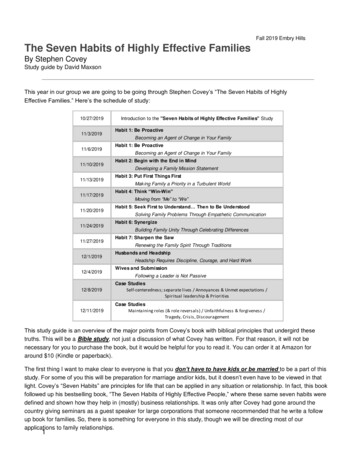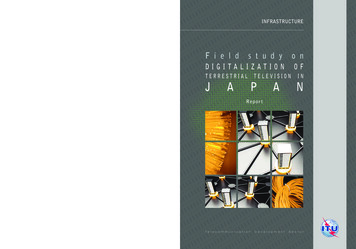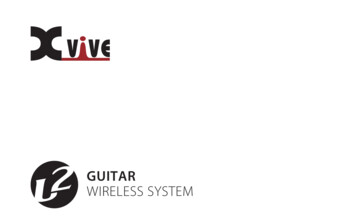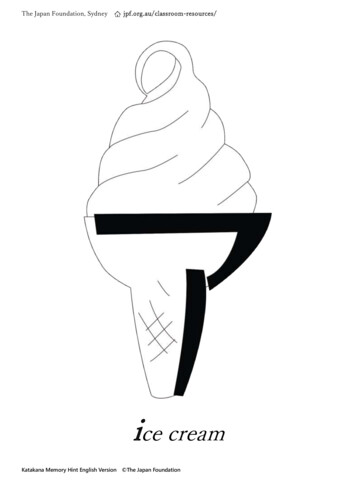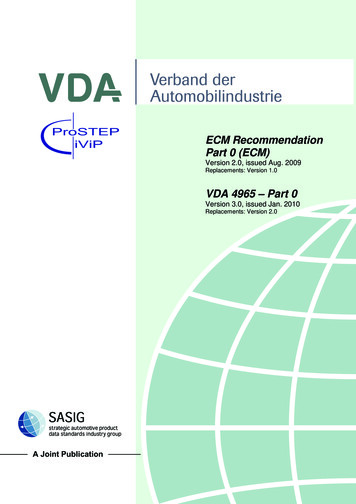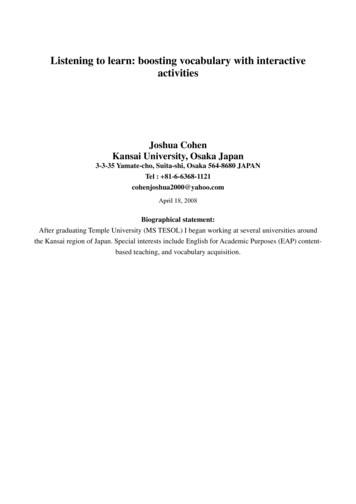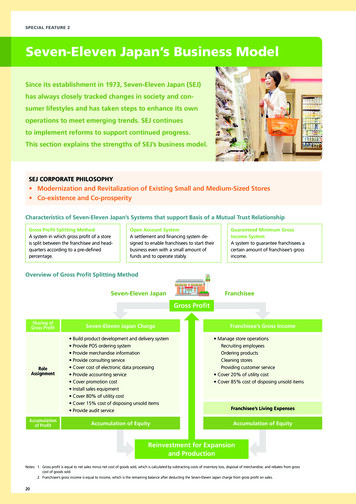
Transcription
SPECIAL FEATURE 2Seven-Eleven Japan’s Business ModelSince its establishment in 1973, Seven-Eleven Japan (SEJ)has always closely tracked changes in society and consumer lifestyles and has taken steps to enhance its ownoperations to meet emerging trends. SEJ continuesto implement reforms to support continued progress.This section explains the strengths of SEJ’s business model.SEJ CORPORATE PHILOSOPHY Modernization and Revitalization of Existing Small and Medium-Sized Stores Co-existence and Co-prosperityCharacteristics of Seven-Eleven Japan’s Systems that support Basis of a Mutual Trust RelationshipGross Profit Splitting MethodA system in which gross profit of a storeis split between the franchisee and headquarters according to a pre-definedpercentage.Open Account SystemA settlement and financing system designed to enable franchisees to start theirbusiness even with a small amount offunds and to operate stably.Guaranteed Minimum GrossIncome SystemA system to guarantee franchisees acertain amount of franchisee’s grossincome.Overview of Gross Profit Splitting MethodSeven-Eleven JapanFranchiseeGross ProfitSharing ofGross ProfitRoleAssignmentAccumulationof ProfitSeven-Eleven Japan Charge Build product development and delivery system Provide POS ordering system Provide merchandise information Provide consulting service Cover cost of electronic data processing Provide accounting service Cover promotion cost Install sales equipment Cover 80% of utility cost Cover 15% cost of disposing unsold items Provide audit serviceAccumulation of EquityFranchisee’s Gross Income Manage store operationsRecruiting employeesOrdering productsCleaning storesProviding customer service Cover 20% of utility cost Cover 85% cost of disposing unsold itemsFranchisee’s Living ExpensesAccumulation of EquityReinvestment for Expansionand ProductionNotes: 1. Gross profit is equal to net sales minus net cost of goods sold, which is calculated by subtracting costs of inventory loss, disposal of merchandise, and rebates from grosscost of goods sold.2. Franchisee’s gross income is equal to income, which is the remaining balance after deducting the Seven-Eleven Japan charge from gross profit on sales.20
STRENGTH1 Franchise SystemSPECIAL FEATURESUnder the franchise system, business operations are divided betweenthe headquarters and franchised stores. This system promotes coexistence and co-prosperity between SEJ and franchisees.Aiming to “modernize and revitalize small and medium-sized retail stores,” SEJ is implementing anoriginal franchise system. SEJ and franchisees are on an equal footing, and there is a clear divisionof roles. The gross profit splitting method is used for the division of profit. As a result, the focus is noton increasing sales but rather on increasing gross profit, fostering co-existence and co-prosperityamong all parties.Store Support through the Visits of OFCsAdvice on store operationsto the franchised storesHeadquartersManagers’ meeting Thought process oforder placement Sales methods/productdisplay/serving customersFC meeting(general meeting)OFCsFranchised storeVisits each ofhis/her assignedstores twice a weekor more In-store infrastructuredevelopmentOFCs from all over thecountry participate to sharethe latest information. Information utilizationmethods Catchment areasurvey methods Financial figure analysis, etc.Zone meetingDistrict Office meetingSEJ has about 1,950 Operations Field ConsultantsAfter general meetings,subcommittee meetings are heldon a regular basis.(OFCs) in Japan, and by maintaining closecommunications, these OFCs can provideOFCs attend meetingsin their zones and districtsto exchange information.appropriate support in accordance with theoperational situation of the franchised store.Contract Type of Franchised StoresType of ownershipLand and buildingsType A (4,263 stores)Type C (9,344 stores)Franchisee providesSeven-Eleven Japan providesSales equipment, computers, etc.Seven-Eleven Japan providesContract period15 yearsUtilitiesSeven-Eleven Japan charge (royalty)Incentive system for multi-store operationsSeven-Eleven Japan 80%; Franchisee 20%43% of gross profitAn amount calculated on a sliding scale based on gross profit5-year incentives and 15-year contract renewal incentives (reductions in franchise charge) offeredWhen one franchisee operates 2 or more 7-Eleven stores, a 3% incentive charge is applied to the second andsubsequent stores.When franchisees that have operated a 7-Eleven store for over five years open a new 7-Eleven store, the “incentivefor stores open over five years” is applied to the new store from the beginning of its operation.Cost of disposing unsold itemsMinimum guaranteeSeven-Eleven Japan 15%; Franchisee 85%19 million yen(franchisee’s annual gross profit)17 million yen(franchisee’s annual gross profit)Notes: 1. Number of stores are as of February 29, 2012.2. The condition for the Seven-Eleven Japan charge (royalty) and minimum guarantee applies to stores that are open for 24 hours a day.3. Gross profit is equal to net sales minus net cost of goods sold, which is calculated by subtracting costs of inventory loss, disposal of merchandise, and rebates from gross costof goods sold.Seven & i Holdings Annual Report 201221
SPECIAL FEATURE 2STRENGTHSEVEN-ELEVEN JAPAN’S BUSINESS MODEL2 Store NetworkHigh-density, concentrated store openings are the foundation ofhigh-value-added products and services.Through the use of the market concentration strategy, SEJ has been able to establish a distributionsystem and implement product strategies that leverage the distinctive features of high store densities.Moving forward, SEJ will continue working to open stores with a focus on quality. For example, SEJwill carefully consider the sites for new stores in accordance with strict conditions, thereby steadilyenhancing profitability on a store-by-store basis.Merit of Market ConcentrationGreater Familiarity with CustomersEfficient Construction of Production BasesEffective Sales PromotionEfficient Construction of Distribution StructureImproved Efficiency in Guiding Franchised StoresPrevent Entry by CompetitorsShare by store numbersAs of February 29, 2012,Seven-Eleven Japan operates7-Eleven stores in 39 of 47prefectures in Japan.Seven-Eleven Japan30.6%Others13.7%Circle .9%(as of February 29, 2012)Akita Prefecture, where we startedAverage daily sales per store for FY2012to open stores in May 2012. Thousand8007815046339360209824514842978227 9255456461423827131386 379 363929 555170657 52281388225 apanIndustryaverage(as of February 29, 2012)Indicates prefecture where we open stores only in limited areas byutilizing existing commissaries and distribution networks ofadjacent prefectures.Note: Industry average is the average of three major listed conveniencestore chains.Sources: Current Survey of Commerce (Ministry of Economy, Tradeand Industry), Public information from each companyFor further information regarding SEJ’s store-opening initiatives, please refer to the Corporate Outline 2012 on pages 16, 17, and 33.22
STRENGTH3 Item-by-item ManagementSPECIAL FEATURESTo implement item-by-item management, SEJ is building originalinformation systems and distribution networks and is working tomaximize the efficiency of store operations as well as profits.SEJ has built one of the world’s largest information networks, which links stores, headquarters, combined distribution centers, and suppliers. In addition, SEJ has established a combined distributionsystem that is managed by third parties. This is a practical system that offers logistics advantages forcustomers, franchised stores, and suppliers.System that Realizes Item-by-item ManagementInformation NetworkProductsHeadquartersStoresStore ComputerInformation including financial data, sales data for each time zone, new products andsales promotion plans, and regional weather is displayed.POS RegisterWhen sales transactionsoccur, sales data is storedand transmitted to headquarters through the storecomputer.Graphic Order TerminalThis terminal is used forplacing orders on the salesfloors.Scanner TerminalThis is used for productcheck-in, registrationof product display positions, and product freshness control.Manufacturers,suppliers, etc.Temperature-separated Combined Distribution CentersGroup companies adopt a combined distribution system for greater efficiency, which allows products from different suppliers and manufacturers to be deliveredto stores on the same truck. The combined distribution centers are operated by third parties.Combined distribution center forrice-based productsLunch boxes, rice balls, and oven-fresh breadCombined distribution center forchilled productsSandwiches, delicatessen foods, and milkCombined distribution center forambient-temperature productsConfectioneries, instant noodles, and soft drinks20º control3 timesdayIce cream, frozen foods, and ice cubesTohan distribution center5º control3 timesCombined distribution center forfrozen productsdayBooks and magazines–20º control3 to 7 times6 timesweekweekNormal temperature controlEvery dayAdvantages of Temperature-separated Combined Distribution SystemUnder SEJ’s combined distribution system, products from different suppliers and manufacturers areloaded onto the same truck and delivered to stores. With temperature-separated combined distribution, products are maintained at the appropriate temperature from supplier and manufacturer tostore, facilitating the efficient delivery of fresh products to stores.For further information regarding information and distribution systems, please refer to the Corporate Outline 2012 on pages 22 and 23.Seven & i Holdings Annual Report 201223
SPECIAL FEATURE 2STRENGTHSEVEN-ELEVEN JAPAN’S BUSINESS MODEL4 Original ProductsSEJ’s ability to differentiate its operations from those of competitorsis the result of a lineup of more than 1,000 original products. Thislineup, which is SEJ’s greatest strength, is the key factor behindstrong store loyalty.SEJ is working together with the Nihon Delica Foods Association* to develop original dailyfood products, which are SEJ’s core product. SEJ places a high priority on ensuring that theproduction facilities and distribution centers for its original daily food products are used onlyby SEJ. This enables SEJ to differentiate itself in the areas of product development, food safetymanagement, and quality control.* Nihon Delica Foods Association: Established in 1979, centered on manufacturers of rice-based products. Currently, about 80 companies areparticipating in the association, including makers of rice-based products, bakery products, delicatessen items, noodles, and Japanese pickles. Theassociation is implementing initiatives in such areas as product development, quality control, joint procurement, and environmental countermeasures.Original Product Development Framework(as of February 29, 2012)StoresDaily orders from 14,005 storesSeven-Eleven JapanDaily Food Production Facilities169 sites(of which, 156 are dedicated sites)Online systemTemperature-separated Distribution CentersDaily deliveries from distribution centers149 sitesProduct Assortment that Reflects Customer NeedsProducts recommendedby headquartersApprox.4,800Products carriedat a storeApprox.New productsintroduced per week2,800Approx.Approx.70%Processed food:soft drinks, snacks,instant noodles,retort-packedfood products, etc.Nonfood:daily commodities,cosmetics, magazines,game software, etc.35.1%Daily food:milk, dairy products,desserts, fresh pastries, etc.100Products replacedannually26.6% 3,280.5billion12.3%26.0%Fast food:rice products,noodles, salads,sozai prepareddishes, oden, etc.For further information regarding SEJ’s product development system, please refer to the Corporate Outline 2012 on pages 20 and 22.24
STRENGTH5 Service DevelopmentSPECIAL FEATURESSEJ is aiming to meet customer needs with an expanded range ofservices and to increasingly offer “close by convenient stores.”To make its stores a part of the daily lifestyle infrastructure, SEJ has expanded its range of servicesthat are useful in daily life. A diverse range of SEJ services contributes to growth in the number ofcustomer store visits. These services include ATM services, the acceptance of bill payments, mealdelivery services, and ticket services provided with the use of multi-function copiers.Services that Realize “Close by Convenient Stores”Seven Bank ATMTotal numberof transactions:655 million*Meal delivery service utilizing Seven-Meal Ordering– in store– by phone– by fax– through the InternetSales volume: 10 billion Receiving– in store– at home (delivery)* Fiscal year ended March 31, 2012Payment acceptance serviceService available from multi-function copiersTotal number oftransactions: Tickets for entertainmenteventsSalesvolume ofticket service: 65.1 billion Administrative services(local government services)358 million Expressway bus tickets Sports promotion lottery ticketserviceMessage from Ryuichi Isaka, President of Seven-Eleven Japan Co., Ltd.Striving to be an “irreplaceable” part of the dailylives of customers.In 2011, we recognized anew the important role of “close bycooperative initiatives among depart-convenient stores.” In particular, we worked together with franchisements are operating with a highowners and suppliers to restore operations as rapidly as possibledegree of effectiveness. For ourfollowing the March 11 earthquake. I believe that this experience hasemployees, this experience of achiev-further reinforced the solidarity of the 7-Eleven chain of stores.ing objectives through a process ofThere are ongoing changes in Japan’s social environment, such astrial and error has become an assetthe aging of the population and the increase in working women. Atwith both tangible and intangiblethe same time, however, there is also a decline in the facilities avail-aspects. As a result, I believe that weable for the provision of life support services, such as small andhave established a system that will enable us to strive over the me-medium-sized retail stores, bank branches, and government servicedium term for a record-high level of average daily sales peroffices. As a result of this trend, I believe that convenience stores willstore— 700,000.increasingly be called on to provide “close by convenient services.”“Contributing to local communities through the franchise busi-It is important to always be aware of “what is needed in the salesness” is the starting point of our business, and we believe thatarea,” and to continue to work in accordance with a cycle of hypoth-increasing the satisfaction of franchisees, our most important stake-esis and verification.holders, will drive SEJ’s further growth in the years ahead. MovingThree years ago, we began to use the slogan “close by conve-forward, we will work together with franchise owners to realizenient” for our stores. Over this period, we have made steady prog-“close by convenient” stores and to further enhance the 7-Elevenress in developing awareness among our employees, and thechain’s presence.Seven & i Holdings Annual Report 201225
original franchise system. SEJ and franchisees are on an equal footing, and there is a clear division of roles. The gross profit splitting method is used for the division of profit. As a result, the focus is not on increasing sales but rather on increasing gross profit, fo




